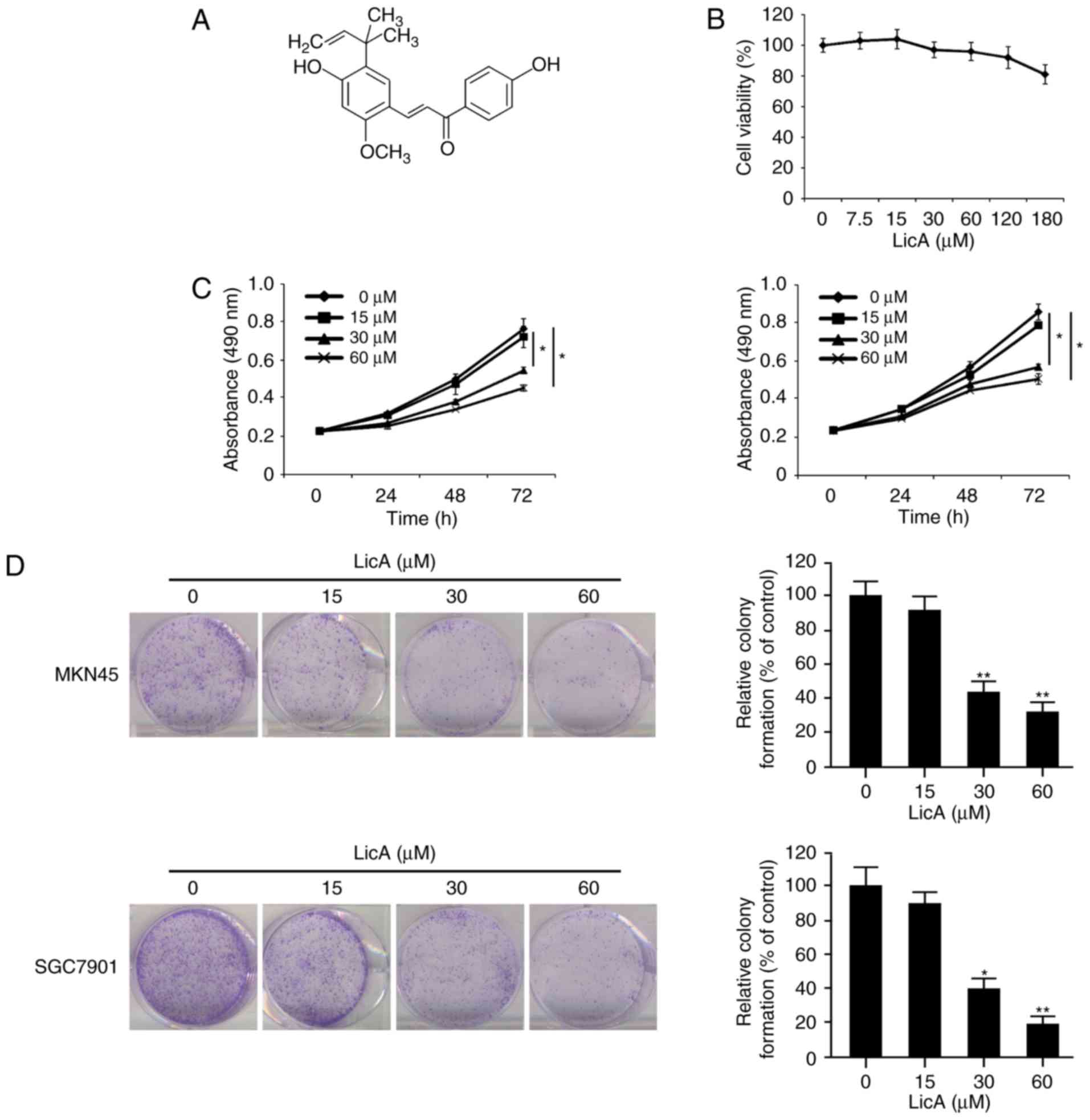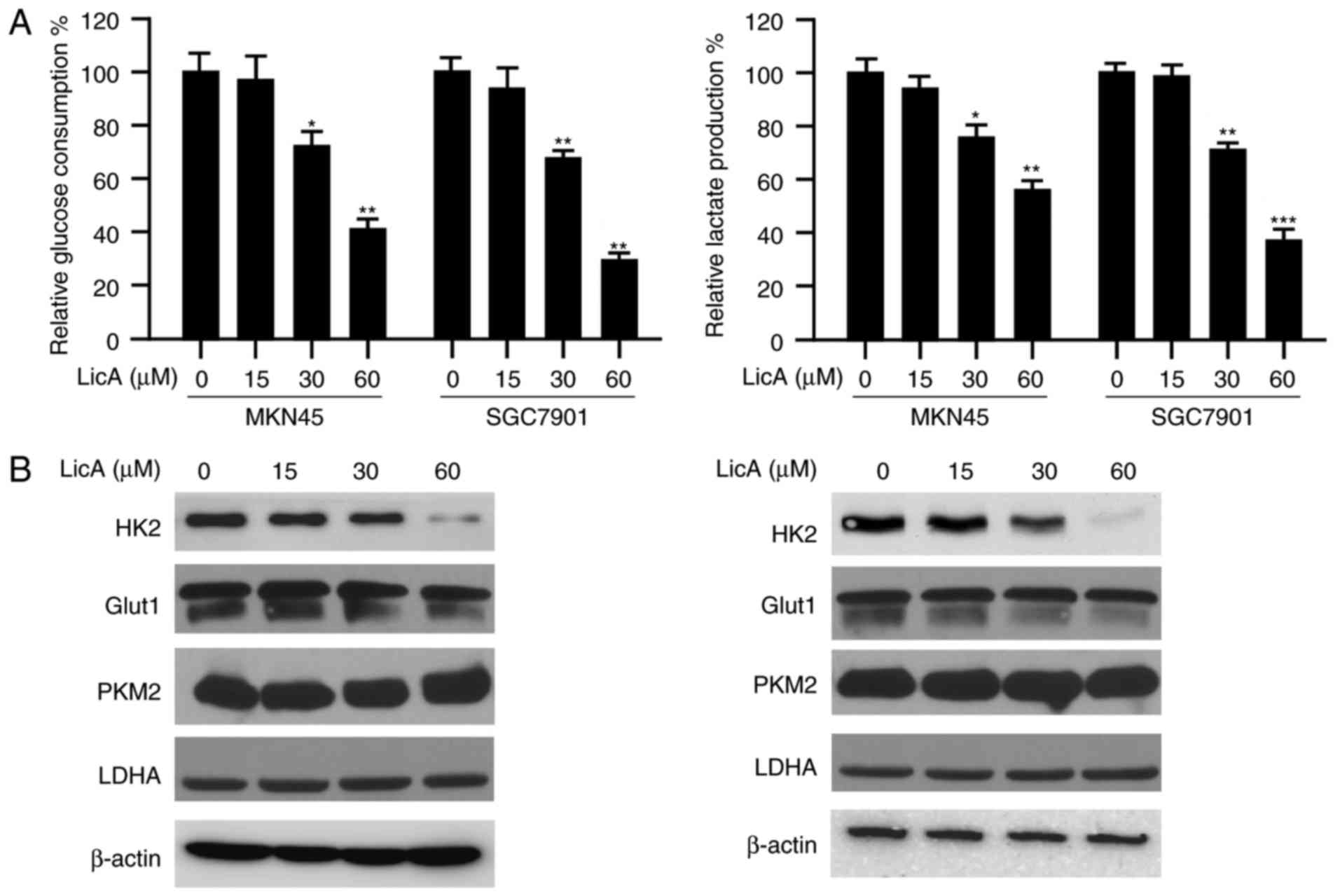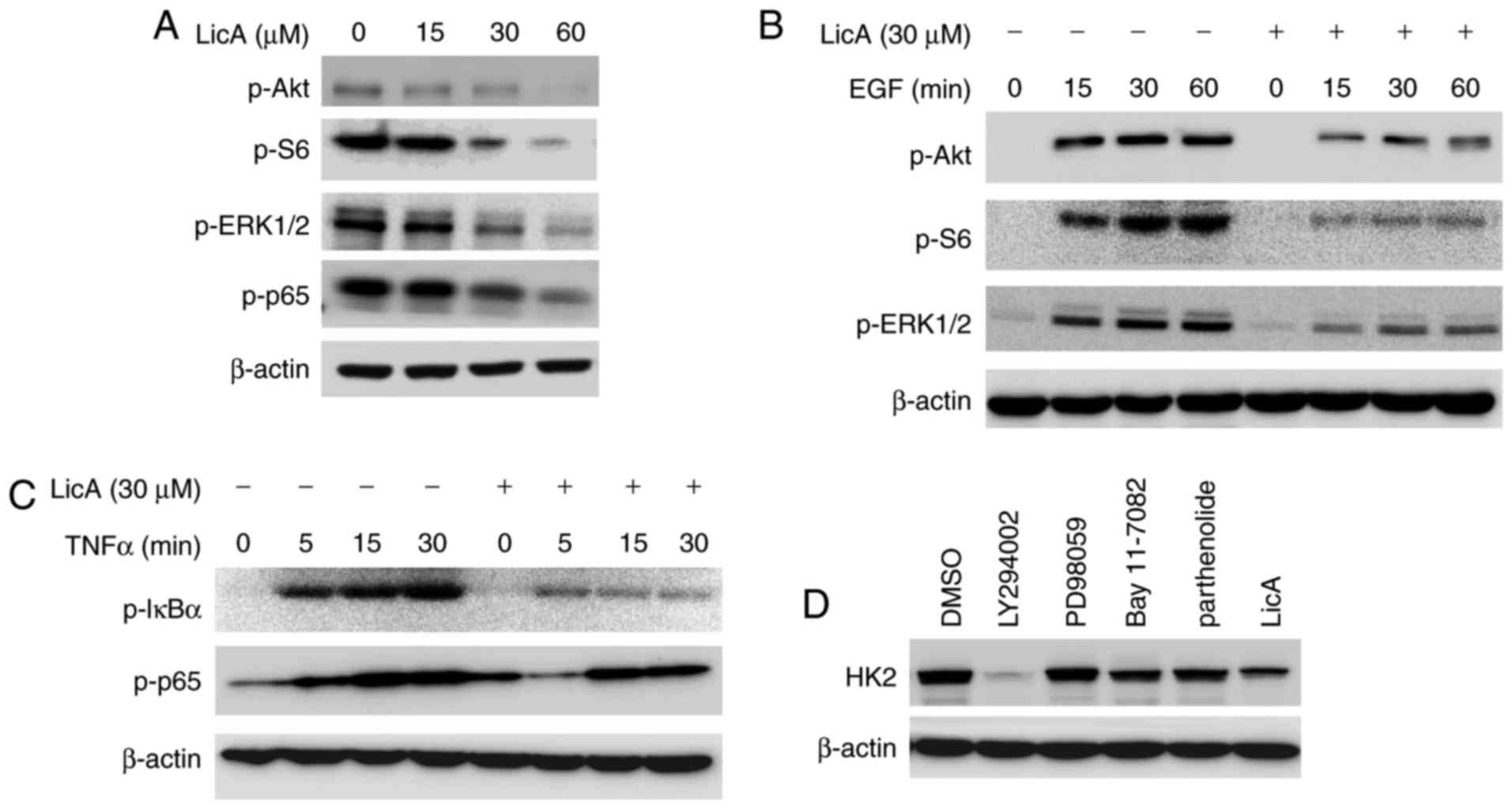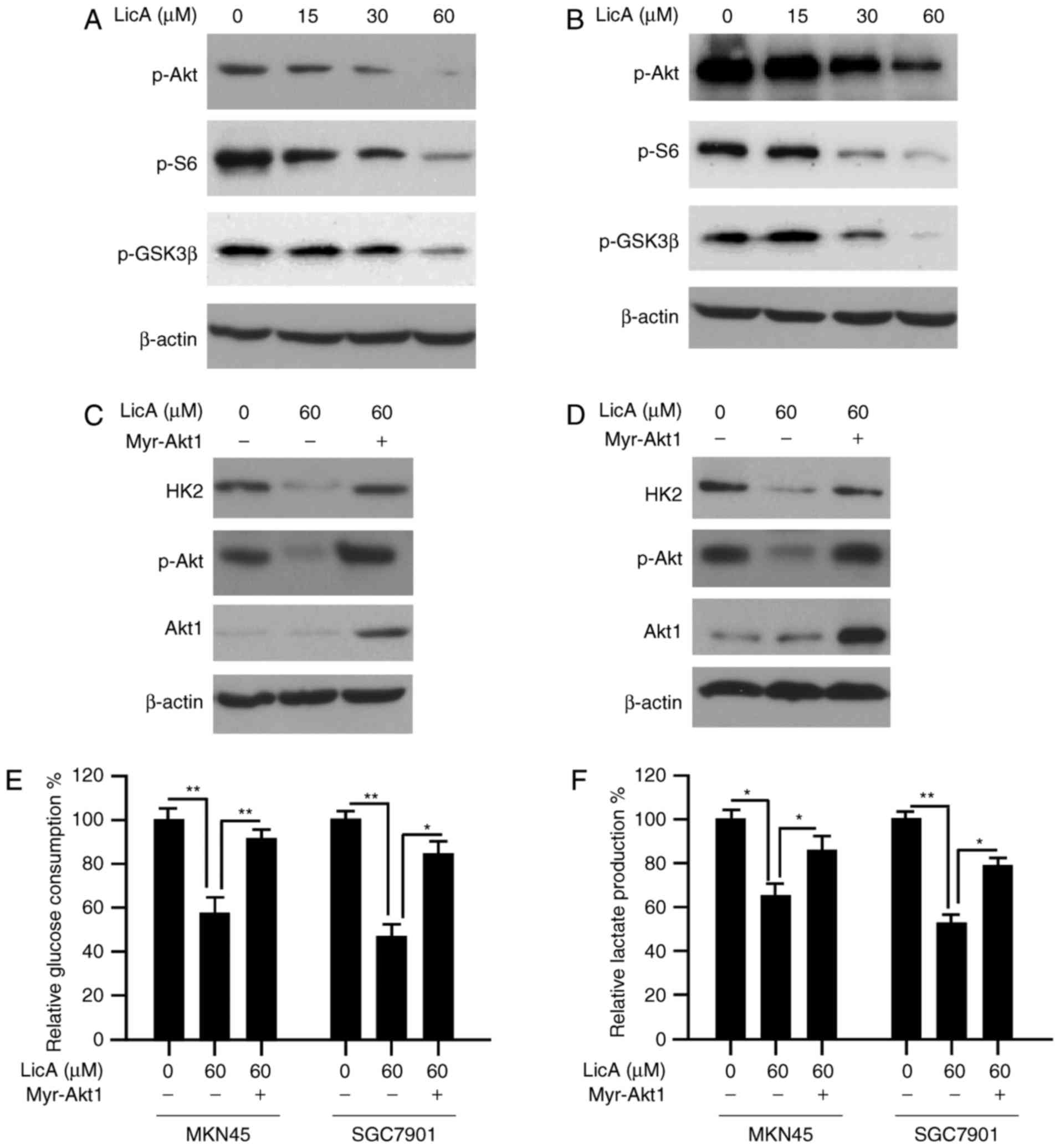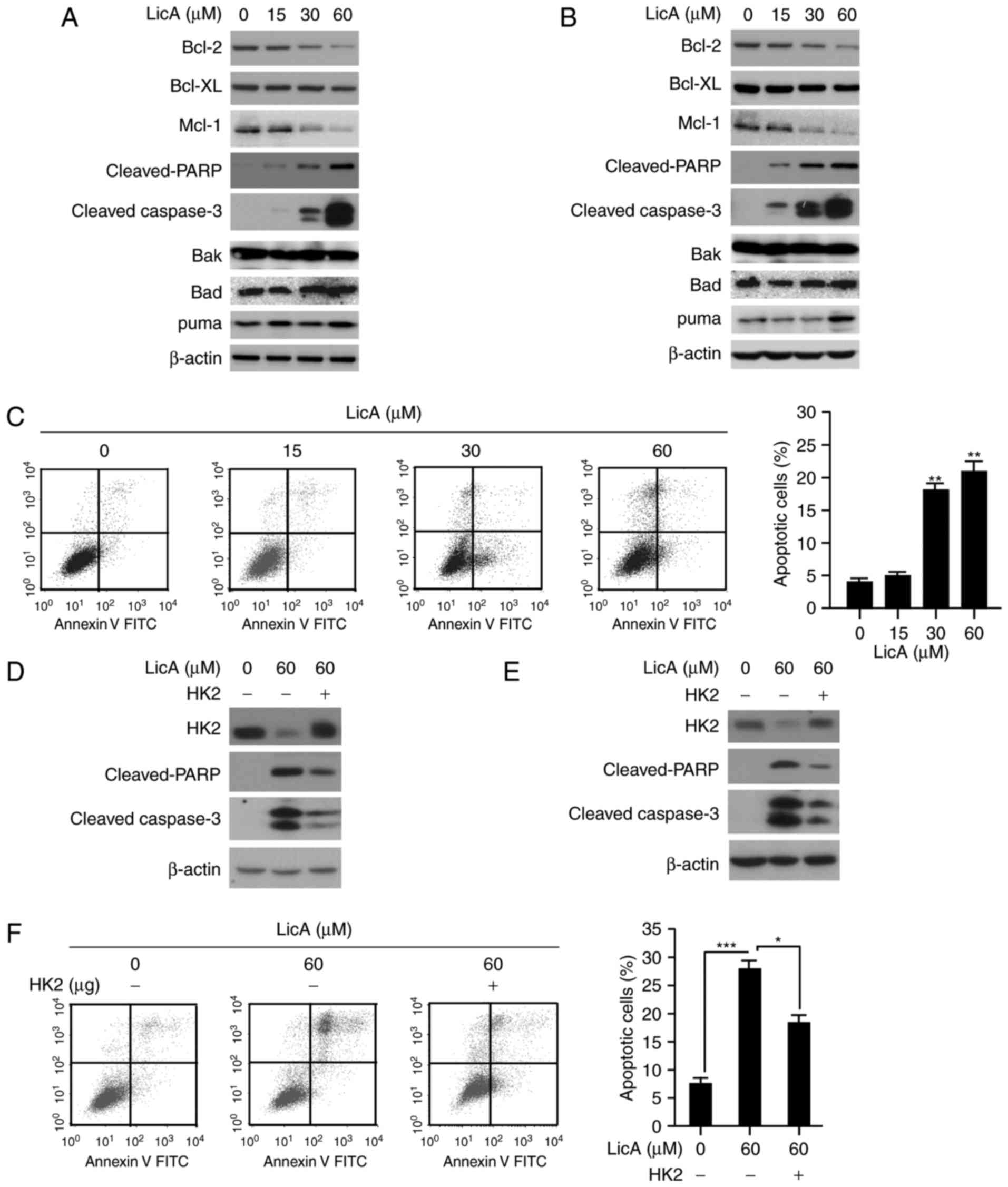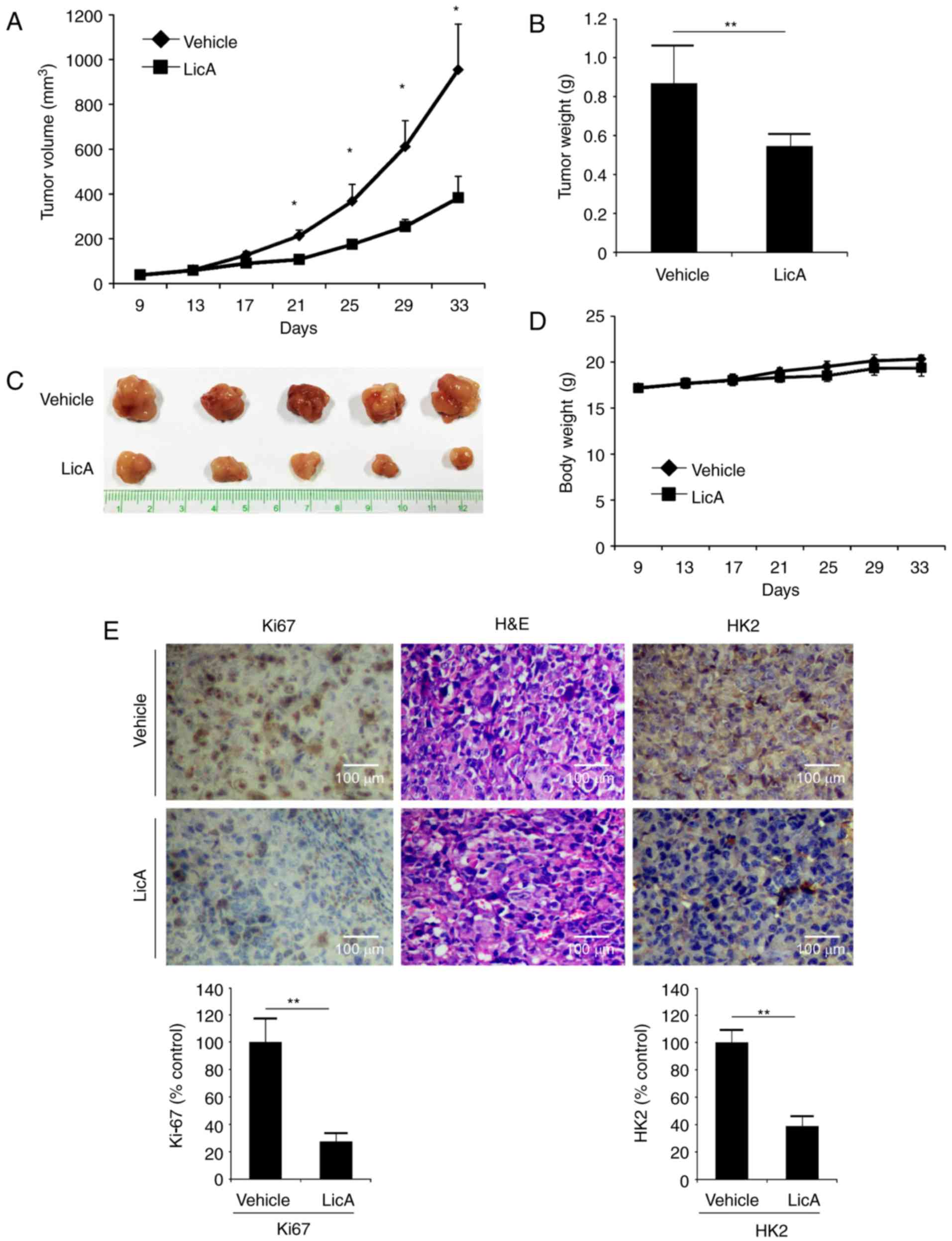Licochalcone A suppresses hexokinase 2-mediated tumor glycolysis in gastric cancer via downregulation of the Akt signaling pathway
- Authors:
- Published online on: December 14, 2017 https://doi.org/10.3892/or.2017.6155
- Pages: 1181-1190
Abstract
Introduction
Glucose is the energy source and the important metabolic intermediate in mammalian cells. Under a condition of sufficient oxygen, glucose is metabolized into H2O and CO2 via the Krebs cycle to generate abundant ATP to satisfy energy requirements. Different from normal cells, in tumor cells glucose is converted to pyruvate and lactate even in the presence of oxygen, which is termed as aerobic glycolysis or the Warburg effect (1). Increased glucose consumption and glycolytic activity are important hallmarks of cancer cells (2). Although tumor glycolysis is not efficient in terms of generating ATP, it supplies a large number of intermediate products for the synthesis of nucleotides, amino acids and lipids which are required for cell proliferation. Moreover, the accumulation of lactate in tumor tissues results in an acidic microenvironment which enhances chemotherapy resistance, tumor migration and metastasis (3). Owing to the importance of tumor glycolysis, increasing attention has been given on how to interfere with this process of cancer cells to provide a promising therapeutic strategy. The first step of glucose metabolism is the conversion to glucose-6-phosphate (G-6P), which is irreversible and is mainly mediated by hexokinases (HKs). To date, four isoforms of HK (HK1-4) have been identified in mammalian tissue. Among all HKs, hexokinase 2 (HK2) upregulation is a major contributor to the elevation of glycolysis. It has been found that HK2 is abnormally expressed in various types of cancers, for instance gastric (4), breast (5) and colorectal cancer (6) and hepatocellular carcinoma (7), and its expression levels are closely associated with tumor grade, prognosis and mortality (6,8,9).
In contrast with small molecules developed through rational chemical design, natural products have more potential to be applied to tumor chemotherapy owing to their structural diversity. Recently, numerous natural compounds have been demonstrated to exert antitumor effects by inhibiting cell growth, promoting cell death and suppressing angiogenesis (10–12). Licochalcone A (LicA) (Fig. 1A) is a characteristic chalcone derived from liquorice, which is also named as ‘Gancao’ and used as a Traditional Chinese Medicine for many generations. LicA was reported to possess different biological activities, including anti-oxidative (13), anti-inflammatory (14), antiviral and antimicrobial activities (15). Recently, increasing evidence has demonstrated that LicA exhibits profound antitumor activities in various types of cancers, such as breast (16), non-small cell lung (17) and cervical cancer. Induction of cell apoptosis, cell cycle arrest and autophagy (16,18,19), inhibition of migration and metastasis (20), and blockade of angiogenesis in tumor tissues (21) have been identified to be the underlying mechanisms.
Although antitumor activities of LicA have been verified, its effect on tumor glycolysis remains largely unknown. In the present study, we investigated the effect of LicA on tumor glycolysis in gastric cancer cells as well as the underlying mechanisms. The results demonstrated that LicA exhibited substantial activities against tumor glycolysis by reducing HK2 expression. Further investigation illustrated that the decrease in HK2 by LicA was due to the blockade of the Akt signaling pathway.
Materials and methods
Cell lines and reagents
Gastric cancer cell lines MKN45 and SGC7901 and the gastric epithelial cell GES-1 were purchased from the Chinese Committee of Type Culture Collection Cell Bank, Chinese Academy of Sciences (Shanghai, China). MKN45 and SGC7901 cells were cultured in Dulbecco's modified Eagle's medium (DMEM) containing 10% FBS and 1% antibiotics. The GES-1 cells were cultured in RPMI-1640 medium containing 10% FBS and 1% antibiotics. LicA and specific signaling pathway inhibitors including LY294002, PD98059, Bay11-7082 and parthenolide were purchased from Selleck (Shanghai, China). Primary anti-HK2 (#2867), Glut1 (#12939), PKM2 (#4053), LDHA (#3582), p-Akt (#4060), p-ERK1/2 (#4370), p-p65 (#3031), p-IκBα (#9246), p-S6 (#4858), p-GSK3β (#12456), Akt1 (#75692), MCL-1 (#5453), BCL2 (#2870), BCL-XL (#2764), cleaved caspase-3 (#9664), cleaved PARP (#5625) antibodies and secondary antibodies anti-rabbit IgG HRP (#7074) and anti-mouse IgG HRP (#7076) were products of Cell Signaling Technology Inc. (Beverly, MA, USA). Anti-β-actin antibody (A5316) was purchased from Sigma-Aldrich (St. Louis, MO, USA). Myr-Akt1 plasmid was purchased from Addgene (Cambridge, MA, USA). HK2 (ORF004940) construct was a product of Applied Biological Materials (ABM) Inc. (Richmond, BC, Canada). Lipofectamine® 2000 was purchased from Invitrogen (Carlsbad, CA, USA). Annexin V-FITC and propidium iodide were products of Biolegend (San Diego, CA, USA).
Cell proliferation assay
MKN45 or SGC7901 cells in logarithmic growth phase (3×103/well) were seeded into 96-well plate. Twenty-four hours later, the cells were treated with various concentrations of LicA. At different time points (24, 48 or 72 h), CellTiter96 Aqueous One Solution (Promega Corp., Madison, WI, USA) (20 µl/well) was added to a 96-well plate and the cell viability was assessed according to the manufacturer's protocol.
Clonogenic survival assay
Cells cultured in 10-cm plastic dishes were treated with different concentrations of LicA for 24 h, and the cells were harvested and reseeded into a 6-well plate in duplicate at the appropriate density. The cells were cultured for 1–3 weeks until the colonies with substantially good size (minimum 50 cells per colony) were formed in the control group. After washing with PBS, the colonies were fixed with the fixation solution (methanol:acetic acid 3:1) and then stained with 0.5% crystal violet for 2 h at room temperature. The crystal violet was carefully removed by immersing the plates in tap water repeatedly and the plates were air-dried. The number of colonies was photographed and counted.
Western blot analysis
After the treatment of LicA, gastric cancer cells were lysed with RIPA lysis buffer containing protease cocktail (Roche, Mannheim, Germany) on ice for 30 min. The cell lysate was harvested and centrifugated at 12,000 × g for 5 min, and the supernatant was collected. The protein concentrations were determined by the Bradford assay (Bio-Rad, Philadelphia, PA, USA). Twenty micrograms per sample was subjected to SDS-PAGE and then transferred onto polyvinylidene difluoride membranes (Millipore, Billerica, MA, USA). After blocking the non-specific binding site on the membrane with 5% non-fat milk solution, the membranes were incubated with specific primary antibodies at a dilution of 1:1,000 at 4°C overnight. After washing three times with TBS-Tween-20, the membranes were incubated with HRP-conjugated secondary antibody at a dilution of 1:2,000 at room temperature for 1 h, and then the bands on the membrane were visualized using an enhanced chemiluminescence reagent (Thermo Fisher Scientific, Inc., Waltham, MA, USA).
Glucose uptake and lactate production measurement
Gastric cancer cells (5×105/well) were plated in 6-well tissue culture plate and cultured overnight. Then, the culture medium was discarded and cells were incubated with fresh medium containing different concentrations of LicA for 12 h. The Automatic Biochemical Analyzer (7170A, Hitachi, Tokyo, Japan) was used for the measurement of the levels of glucose and lactate in the culture medium. Protein concentration per sample acted as the control to normalize the relative glucose consumption and lactate production rate.
Flow cytometry
After LicA treatment, MKN45 cells and the cell culture medium were collected and centrifugated. After washing with PBS, the cell pellets were resuspended and stained with Annexin V-FITC and propidium iodide according to the manufacturer's instructions, and then the stained cells were subjected to flow cytometry. The results were analyzed and quantified by a flow cytometer (BD Biosciences, San Jose, CA, USA).
Cell transfection
For Myr-Akt1 or pORF-HK2 transfection, HCC cells were seeded into a 6-well culture plate and grown to 70–90% confluence. Before transfection, the culture medium was replaced with 1.5 ml fresh medium without fetal bovine serum. Plasmid DNA (2.5 µg) and Lipofectamine 2000 reagent (7.5 µl) were diluted with 150 µl Opti-MEM medium respectively and incubated at room temperature for 5 min. The diluted DNA and transfection reagent were mixed and incubated for 10 mins avoiding light, then 250 µl mixture was added per well and the culture medium was replaced with fresh medium with fetal bovine serum after 4–6 h. Forty-eight hours later, the transfected cells were used for further studies.
Xenograft mouse model
In accordance with the protocol approved by the Institutional Animal Care and Use Committee, BALB/ca nude mice maintained under specific pathogen-free (SPF) conditions were subcutaneously injected with MKN45 cells (2×106 cells/mice). Once the tumor was formed and the volume was ~50 mm3, the mice were randomly assigned into a vehicle and experimental group. The vehicle group received 0.2 ml sterile PBS solution, and the experimental group was treated with 10 mg/kg LicA by i.p. injection daily. The tumor volume (V) was measured twice per week with microcalipers and was calculated as V= (length × width2)/2. At the end of the experiment, the mice were sacrificed and the tumors were removed.
Immunohistochemical staining
Tumor tissues isolated from the mice were embedded in paraffin and cut into 5-µm sections. After dewaxing in xylene and hydration in serial ethanol, the slides were boiled in sodium citrate buffer (10 mmol/l, pH 6.0) for 10 min to expose antigens. To block endogenous peroxidase, the slides were treated with 3% H2O2 for 10 min. After incubation with goat serum at room temperature for 1 h, the slides were incubated with the anti-HK2 (1:100) or anti-Ki-67 (1:200) antibody respectively at 4°C in a humidified chamber overnight. Following washing with PBS three times, the slides were hybridized with biotinylated goat anti-rabbit secondary antibody at room temperature for 30 min. After washing with PBS, the sections were probed with HRP-conjugated streptavidin and then visualized with DAB solution. After counterstaining with Harris' hematoxylin, the slides were dehydrated and mounted. The intensity was analyzed by Image-Pro PLUS (v.6) and ImageJ (NIH) software programs.
Statistical analysis
SPSS software (version 13.0; IBM SPSS, Armonk, NY, USA) was used for statistical analysis. Student's t-test or one-way ANOVA was adopted to evaluate statistical significance. P<0.05 indicated a statistically significant difference.
Results
LicA suppresses gastric cancer cell proliferation in vitro
Firstly, we tested the effect of LicA on normal gastric epithelium cell line GES-1. The results showed that LicA had no obvious cytotoxicity at concentrations ≤180 µM (Fig. 1B). We next examined the anti-proliferative activity of LicA in gastric cancer cells in vitro. As shown in Fig. 1C, at the low concentration (15 µM), no obvious inhibitory effect was observed. With the increase in concentration (30–60 µM) and the extension of treatment time (48–72 h), cell proliferation in the MKN45 and SGC7901 cells was significantly inhibited. The IC50 of LicA in MKN45 and SGC7901 cells was 63.57 and 55.56 µM respectively (data not shown). Beyond that, the effect of LicA on clonogenic survival was also investigated. The incubation of LicA resulted in the decrease in colonies formed in the agar, and the number of clones was substantially decreased in a dose-dependent manner. At 60 µM, little colonies were formed after exposure to LicA (Fig. 1D). All these data demonstrated that LicA exerted a profound antitumor activity in gastric cancer cells in vitro.
LicA inhibits tumor glycolysis in gastric cancer cells via reducing HK2
In order to study the effect of LicA on tumor glycolysis, the amount of glucose consumption in gastric cancer cells was determined. As shown in Fig. 2A, after LicA treatment, the glucose consumed by MKN45 and SGC7901 cells was significantly decreased dose-dependently. At the high concentration of 60 µM, ~50% inhibition was observed. Accompanied by the reduction of glucose absorption, the amount of lactate secreted by gastric cancer cells was also decreased significantly. Furthermore, we tested the effect of LicA on key glycolytic enzymes and the results demonstrated that the expression of HK2 was decreased by LicA. The expression of other glycolytic enzymes, such as GLUT1, PKM2 and LDHA, had no obvious change (Fig. 2B). All these data imply that HK2 is involved in the suppression of glycolysis mediated by LicA.
Akt signaling pathway is involved in the regulation of HK2 expression by LicA
To confirm which signaling pathway is engaged in the regulation of HK2 expression, the effect of LicA on the main signaling pathways in gastric cancer cells was investigated. As demonstrated, several signaling pathways in gastric cancer, such as ERK, Akt and NF-κB were blocked by LicA dose-dependently (Fig. 3A). To further validate the inhibition of these pathways, we examined the effect of LicA on EGF-induced activation of ERK and Akt, as well as TNF-α-induced NF-κB activation. As shown in Fig. 3B and C, the activation of ERK, Akt and NF-κB signaling was suppressed by LicA dose and time-dependently. By using different specific signaling pathway inhibitors to treat gastric cancer cells and observe the change in HK2 expression, we identified that LY294002, a specific PI3-K inhibitor, demonstrated a similar effect on HK2 as LicA, implying that the Akt signaling pathway may be involved in the mediation of HK2 expression (Fig. 3D).
Hyperactivation of Akt in gastric cancer cells attenuates LicA-mediated glycolysis suppression
Based on the results shown above, the HK2 decrease caused by LicA may be attributed to the blockade of Akt activation, thus, we tested the effect of LicA on the Akt signaling pathway. After LicA treatment, along with the inactivation of Akt, the phosphorylation of S6 and GSK3β, which are the main downstream signaling of Akt, were inhibited dose-dependently (Fig. 4A and B). To illustrate the importance of Akt in the regulation of HK2 expression, constitutively activated Akt1 (myr-Akt1) was transfected into MKN45 and SGC7901 cells. As expected, with the recovery of Akt activity in gastric cancer cells, HK2 reduction caused by LicA was notably reversed (Fig. 4C and D). Moreover, glucose consumption and lactate production in myr-Akt1 transfected cells were also significantly increased (Fig. 4E and F). These results demonstrated that Akt-mediated HK2 expression plays a pivotal role in the effectd of LicA on tumor glycolysis.
Overexpression of HK2 impairs LicA-induced cell apoptosis
Except glycolysis suppression, LicA also induced apoptosis in gastric cancer cells. The expression of cleaved-caspase-3 and PARP, which are signals of cells undergoing apoptosis, were significantly increased (Fig. 5A and B). The results of FACS analysis also confirmed that MKN45 cells exhibited induced apoptosis dose-dependently; 25% of tumor cells were subjected to apoptosis at 60 µM (Fig. 5C). Furthermore, the anti-apoptotic proteins such as Bcl-2, and Mcl-1 were found to be decreased after LicA treatment, whereas the expression of pro-apoptotic proteins including Bad and Bak had no significant change. In addition to mediating tumor glycolysis, HK2 is also involved in apoptosis regulation. Given the decrease in HK2 expression by LicA, we speculated that HK2 was also involved in LicA-induced cell apoptosis. After exogenous HK2 overexpression in gastric cancer, the apoptosis induced by LicA was substantially attenuated and the expression of cleaved-PARP and caspase-3 was significantly decreased in contrast with the control group, suggesting that HK2 was involved in LicA-induced apoptosis (Fig. 5D-F).
LicA restrains tumor growth in a gastric xenograft model
The in vivo antitumor activity of LicA was investigated in an MKN45 xenograft model. In contrast with the vehicle group, tumor growth in the LicA-treated group was significantly inhibited (Fig. 6A-C). The tumor volume of the vehicle group had reached about 900 mm3, whereas the average volume of the LicA-treated group was ~400 mm3. The tumor weight of the LicA-treated group was also significantly smaller than the vehicle group (0.52 vs. 0.85 g). Based on the change in body weight, no obvious toxicity was observed (Fig. 6D). As shown in Fig. 6E, immunohistochemistry staining of LicA-treated tumor tissues demonstrated that the expression of HK2 was substantially decreased. Meanwhile, the expression of Ki-67, a marker of cell proliferative potential, was also decreased, indicating that LicA inhibited tumor growth in vivo by suppressing tumor glycolysis.
Discussion
Gastric cancer ranks fourth as the most most common malignancy and the second leading cause of cancer-associated mortality. In China, it was estimated the mortality reached ~498,000 in 2015 (22). Despite the advance in targeted therapy and early diagnosis of gastric cancer, the progress in clinical therapy remains limited. Apart from small molecules synthesized by medical chemistry, natural products have drawn increasing attention in cancer chemopreventive therapies (23). The results of the present study demonstrated that LicA had profound potency against gastric cancer in vitro and in vivo by suppressing tumor glycolysis. Through reducing HK2 expression, the glycolysis in gastric cancer cells was markedly inhibited by LicA. Meanwhile, owing to the decrease in HK2, gastric cancer cells were subjected to induction of apoptosis. Further studies identified that the inhibition of the Akt signaling pathway was involved in the regulation of HK2 activity.
The potency of LicA in different tumor types is highly different. As reported, breast cancer cells demonstrated high sensitivity to LicA with an IC50 of 20 µM (16), and the IC50 of LicA in cervical cancer and head and neck cancer was 40 and 100 µM, respectively (18,19). In our study, the IC50 of LicA in gastric cancer was ~60 µM, which was in accordance with the results reported by Hao et al (24). In cervical cancer, an i.p injection of 10 mg/kg LicA substantially inhibited the xenograft growth (19). Although the sensitivity of head and neck cancer to LicA was relatively low, intravenous injection of 10 mg/kg LicA also significantly delayed the tumor growth (18). Therefore, in our study, we also chose 10 mg/kg for the in vivo experiments. As expected, the growth of MKN45 xenografts was substantially attenuated by daily treatment of 10 mg/kg LicA.
Tumor glycolysis is an important hallmark of cancer cells. Clinical observations verified the 18F-FDG uptake is an independent and significant prognostic indicator of tumor recurrence in gastric cancer (25,26). The level of glucose uptake was closely correlated with the overexpression of glycolytic enzymes, such as GLUT, HK2, PKM2, which were found to be overexpressed in gastric cancer tissue and were significantly correlated with disease progression (27–30). After LicA treatment, the expression of HK2 was substantially decreased, and both glucose absorption and lactate secretion in gastric cancer cells were significantly inhibited. Meanwhile, the western blotting results demonstrated that, except HK2, other key enzymes involved in glycolysis regulation had no obvious change. Additionally, Akt exogenous overexpression, which led to the recovery of HK2 expression, significantly rescued glycolysis suppression by LicA, suggesting that HK2 plays an important role in LicA-mediated suppression of tumor glycolysis.
The regulation of HK2 expression in tumor cells is complex. Like other glycolytic enzymes, its expression is primarily mediated by altered oncogenic pathways, such as PI3K-Akt, NF-κB, c-myc, HIF-1α and p53 (31). After LicA treatment, the signaling pathways in gastric cancer cells including Akt, ERK and NF-κB were blocked. Further investigation clarified that HK2 downregulation was mainly attributed to the effect of LicA on the Akt signaling pathway. Except LY294002, other selective signaling pathway inhibitors had no effect on HK2 expression. Beyond that, HK2 reduction caused by LicA was dramatically attenuated after Akt overexpression, further confirming that the Akt signaling pathway is involved in the regulation of HK2 by LicA. In other cancers, such as colorectal (32), non-small cell lung cancer (33,34), pediatric osteosarcoma (35), HK2 expression was also found to be regulated by Akt activity. However, further investigation is needed to elaborate the detailed mechanism of how HK2 is mediated by Akt.
Numerous studies had reported that LicA induced apoptosis in cancer cells via various mechanisms. In our study, the results demonstrated that HK2 plays a pivotal role in LicA-induced cell apoptosis in gastric cancer cells. Except the involvement of tumor glycolysis regulation, HK2 interacts with VDAC-1 on the outer mitochondria membrane to maintain membrane integrity under stressed condition and prevents cancer cells from apoptosis (36). With the decrease of HK2, gastric cancer cells underwent induced apoptosis by LicA, as evidenced by the increase in cleaved caspase-3 and PARP and the results of Annexin V-PI double staining. LicA-induced apoptosis was significantly declined after exogenous introduction of HK2, verifying that the decrease of HK2 was an important attributor to the apoptosis induction by LicA. Recent studies have reported that HK2 overexpression is closely correlated with chemotherapy resistance in various cancers, such as in epithelial ovarian, prostate and breast cancer (37–39). Given the effect of LicA on HK2, we speculate that LicA may have the potential to promote the efficacy of other chemotherapies in combinational usage.
Taken together, to the best of our knowledge, the present study is the first to report the effect of LicA on tumor glycolysis. We found that the reduction in HK2 was an important underlying mechanism for LicA to display its effects on glycolysis suppression and apoptosis induction. Moreover, we also disclosed that the decrease in HK2 caused by LicA was mainly attributed to the inhibition of the Akt signaling pathway. Our studies provide a preclinical rationale for LicA, or its derivatives to be administered for gastric cancer therapy.
Acknowledgements
The present study was supported by the Foundation of the Priority Academic Program Development of Jiangsu Higher Education Institutions (PAPD), the Jiangsu Provincial Special Program of Medical Science (BL2014100), the Jiangsu Hospital of TCM (Y14074) and the National Natural Science Foundation of China (nos. 81202954 and 81473605).
References
|
Lee N and Kim D: Cancer Metabolism: Fueling more than just growth. Mol Cells. 39:847–854. 2016. View Article : Google Scholar : PubMed/NCBI | |
|
Hanahan D and Weinberg RA: Hallmarks of cancer: The next generation. Cell. 144:646–674. 2011. View Article : Google Scholar : PubMed/NCBI | |
|
Doherty JR and Cleveland JL: Targeting lactate metabolism for cancer therapeutics. J Clin Invest. 123:3685–3692. 2013. View Article : Google Scholar : PubMed/NCBI | |
|
Rho M, Kim J, Jee CD, Lee YM, Lee HE, Kim MA, Lee HS and Kim WH: Expression of type 2 hexokinase and mitochondria-related genes in gastric carcinoma tissues and cell lines. Anticancer Res. 27A:1–258. 2007. | |
|
Palmieri D, Fitzgerald D, Shreeve SM, Hua E, Bronder JL, Weil RJ, Davis S, Stark AM, Merino MJ, Kurek R, et al: Analyses of resected human brain metastases of breast cancer reveal the association between up-regulation of hexokinase 2 and poor prognosis. Mol Cancer Res. 7:1438–1445. 2009. View Article : Google Scholar : PubMed/NCBI | |
|
Liu Y, Wu K, Shi L, Xiang F, Tao K and Wang G: Prognostic significance of the metabolic marker hexokinase-2 in various solid tumors: A meta-analysis. PLoS One. 11:e01662302016. View Article : Google Scholar : PubMed/NCBI | |
|
Zhang ZF, Feng XS, Chen H, Duan ZJ, Wang LX, Yang D, Liu PX, Zhang QP, Jin YL, Sun ZG, et al: Prognostic significance of synergistic hexokinase-2 and beta2-adrenergic receptor expression in human hepatocelluar carcinoma after curative resection. BMC Gastroenterol. 16:572016. View Article : Google Scholar : PubMed/NCBI | |
|
Kwee SA, Hernandez B, Chan O and Wong L: Choline kinase alpha and hexokinase-2 protein expression in hepatocellular carcinoma: Association with survival. PLoS One. 7:e465912012. View Article : Google Scholar : PubMed/NCBI | |
|
Hamabe A, Yamamoto H, Konno M, Uemura M, Nishimura J, Hata T, Takemasa I, Mizushima T, Nishida N, Kawamoto K, et al: Combined evaluation of hexokinase 2 and phosphorylated pyruvate dehydrogenase-E1α in invasive front lesions of colorectal tumors predicts cancer metabolism and patient prognosis. Cancer Sci. 105:1100–1108. 2014. View Article : Google Scholar : PubMed/NCBI | |
|
Yu X, Deng Q, Li W, Xiao L, Luo X, Liu X, Yang L, Peng S, Ding Z, Feng T, et al: Neoalbaconol induces cell death through necroptosis by regulating RIPK-dependent autocrine TNFα and ROS production. Oncotarget. 6:1995–2008. 2015. View Article : Google Scholar : PubMed/NCBI | |
|
Yu X, Li W, Deng Q, You S, Liu H, Peng S, Liu X, Lu J, Luo X, Yang L, et al: Neoalbaconol inhibits angiogenesis and tumor growth by suppressing EGFR-mediated VEGF production. Mol Carcinog. 56:1414–1426. 2017. View Article : Google Scholar : PubMed/NCBI | |
|
Lee KW, Bode AM and Dong Z: Molecular targets of phytochemicals for cancer prevention. Nat Rev Cancer. 11:211–218. 2011. View Article : Google Scholar : PubMed/NCBI | |
|
Chen X, Liu Z, Meng R, Shi C and Guo N: Antioxidative and anticancer properties of Licochalcone A from licorice. J Ethnopharmacol. 198:331–337. 2017. View Article : Google Scholar : PubMed/NCBI | |
|
Hu J and Liu J: Licochalcone A attenuates kipopolysaccharide-induced acute kidney injury by inhibiting NF-κB activation. Inflammation. 39:569–574. 2016. View Article : Google Scholar : PubMed/NCBI | |
|
Wang L, Yang R, Yuan B, Liu Y and Liu C: The antiviral and antimicrobial activities of licorice, a widely-used Chinese herb. Acta Pharm Sin B. 5:310–315. 2015. View Article : Google Scholar : PubMed/NCBI | |
|
Bortolotto LF, Barbosa FR, Silva G, Bitencourt TA, Beleboni RO, Baek SJ, Marins M and Fachin AL: Cytotoxicity of trans-chalcone and licochalcone A against breast cancer cells is due to apoptosis induction and cell cycle arrest. Biomed Pharmacother. 85:425–433. 2017. View Article : Google Scholar : PubMed/NCBI | |
|
Tang ZH, Chen X, Wang ZY, Chai K, Wang YF, Xu XH, Wang XW, Lu JH, Wang YT, Chen XP, et al: Induction of C/EBP homologous protein-mediated apoptosis and autophagy by licochalcone A in non-small cell lung cancer cells. Sci Rep. 6:262412016. View Article : Google Scholar : PubMed/NCBI | |
|
Park MR, Kim SG, Cho IA, Oh D, Kang KR, Lee SY, Moon SM, Cho SS, Yoon G, Kim CS, et al: Licochalcone-A induces intrinsic and extrinsic apoptosis via ERK1/2 and p38 phosphorylation-mediated TRAIL expression in head and neck squamous carcinoma FaDu cells. Food Chem Toxicol. 77:34–43. 2015. View Article : Google Scholar : PubMed/NCBI | |
|
Tsai JP, Lee CH, Ying TH, Lin CL, Lin CL, Hsueh JT and Hsieh YH: Licochalcone A induces autophagy through PI3K/Akt/mTOR inactivation and autophagy suppression enhances Licochalcone A-induced apoptosis of human cervical cancer cells. Oncotarget. 6:28851–28866. 2015. View Article : Google Scholar : PubMed/NCBI | |
|
Huang HC, Tsai LL, Tsai JP, Hsieh SC, Yang SF, Hsueh JT and Hsieh YH: Licochalcone A inhibits the migration and invasion of human lung cancer cells via inactivation of the Akt signaling pathway with downregulation of MMP-1/-3 expression. Tumour Biol. 35:12139–12149. 2014. View Article : Google Scholar : PubMed/NCBI | |
|
Kim YH, Shin EK, Kim DH, Lee HH, Park JH and Kim JK: Antiangiogenic effect of licochalcone A. Biochem Pharmacol. 80:1152–1159. 2010. View Article : Google Scholar : PubMed/NCBI | |
|
Chen W, Zheng R, Baade PD, Zhang S, Zeng H, Bray F, Jemal A, Yu XQ and He J: Cancer statistics in China, 2015. CA Cancer J Clin. 66:115–132. 2016. View Article : Google Scholar : PubMed/NCBI | |
|
Kinghorn AD, DE Blanco EJ, Lucas DM, Rakotondraibe HL, Orjala J, Soejarto DD, Oberlies NH, Pearce CJ, Wani MC, Stockwell BR, et al: Discovery of anticancer agents of diverse natural origin. Anticancer Res. 36:5623–5637. 2016. View Article : Google Scholar : PubMed/NCBI | |
|
Hao W, Yuan X, Yu L, Gao C, Sun X, Wang D and Zheng Q: Licochalcone A-induced human gastric cancer BGC-823 cells apoptosis by regulating ROS-mediated MAPKs and PI3K/AKT signaling pathways. Sci Rep. 5:103362015. View Article : Google Scholar : PubMed/NCBI | |
|
Lee JW, Lee SM, Lee MS and Shin HC: Role of ¹8F-FDG PET/CT in the prediction of gastric cancer recurrence after curative surgical resection. Eur J Nucl Med Mol Imaging. 39:1425–1434. 2012. View Article : Google Scholar : PubMed/NCBI | |
|
Coupe NA, Karikios D, Chong S, Yap J, Ng W, Merrett N and Lin M: Metabolic information on staging FDG-PET-CT as a prognostic tool in the evaluation of 97 patients with gastric cancer. Ann Nucl Med. 28:128–135. 2014. View Article : Google Scholar : PubMed/NCBI | |
|
Watanabe Y, Suefuji H, Hirose Y, Kaida H, Suzuki G, Uozumi J, Ogo E, Miura M, Takasu K, Miyazaki K, et al: 18F-FDG uptake in primary gastric malignant lymphoma correlates with glucose transporter 1 expression and histologic malignant potential. Int J Hematol. 97:43–49. 2013. View Article : Google Scholar : PubMed/NCBI | |
|
Qiu MZ, Han B, Luo HY, Zhou ZW, Wang ZQ, Wang FH, Li YH and Xu RH: Expressions of hypoxia-inducible factor-1α and hexokinase-II in gastric adenocarcinoma: The impact on prognosis and correlation to clinicopathologic features. Tumour Biol. 32:159–166. 2011. View Article : Google Scholar : PubMed/NCBI | |
|
Yin L, Wang X, Luo C, Liu H, Zhang L, Zhang H and Zhang Y: The value of expression of M2-PK and VEGF in patients with advanced gastric cancer. Cell Biochem Biophys. 67:1033–1039. 2013. View Article : Google Scholar : PubMed/NCBI | |
|
Lim JY, Yoon SO, Seol SY, Hong SW, Kim JW, Choi SH and Cho JY: Overexpression of the M2 isoform of pyruvate kinase is an adverse prognostic factor for signet ring cell gastric cancer. World J Gastroenterol. 18:4037–4043. 2012. View Article : Google Scholar : PubMed/NCBI | |
|
Mathupala SP, Ko YH and Pedersen PL: Hexokinase II: Cancer's double-edged sword acting as both facilitator and gatekeeper of malignancy when bound to mitochondria. Oncogene. 25:4777–4786. 2006. View Article : Google Scholar : PubMed/NCBI | |
|
Chen GQ, Tang CF, Shi XK, Lin CY, Fatima S, Pan XH, Yang DJ, Zhang G, Lu AP, Lin SH, et al: Halofuginone inhibits colorectal cancer growth through suppression of Akt/mTORC1 signaling and glucose metabolism. Oncotarget. 6:24148–24162. 2015.PubMed/NCBI | |
|
Li W, Ma X, Li N, Liu H, Dong Q, Zhang J, Yang C, Liu Y, Liang Q, Zhang S, et al: Resveratrol inhibits Hexokinases II mediated glycolysis in non-small cell lung cancer via targeting Akt signaling pathway. Exp Cell Res. 349:320–327. 2016. View Article : Google Scholar : PubMed/NCBI | |
|
Li W, Gao F, Ma X, Wang R, Dong X and Wang W: Deguelin inhibits non-small cell lung cancer via down-regulating Hexokinases II-mediated glycolysis. Oncotarget. 8:32586–32599. 2017.PubMed/NCBI | |
|
Zhuo B, Li Y, Li Z, Qin H, Sun Q, Zhang F, Shen Y, Shi Y and Wang R: PI3K/Akt signaling mediated Hexokinase-2 expression inhibits cell apoptosis and promotes tumor growth in pediatric osteosarcoma. Biochem Biophys Res Commun. 464:401–406. 2015. View Article : Google Scholar : PubMed/NCBI | |
|
Zhou Y, Lu N, Qiao C, Ni T, Li Z, Yu B, Guo Q and Wei L: FV-429 induces apoptosis and inhibits glycolysis by inhibiting Akt-mediated phosphorylation of hexokinase II in MDA-MB-231 cells. Mol Carcinog. 55:1317–1328. 2016. View Article : Google Scholar : PubMed/NCBI | |
|
Suh DH, Kim MA, Kim H, Kim MK, Kim HS, Chung HH, Kim YB and Song YS: Association of overexpression of hexokinase II with chemoresistance in epithelial ovarian cancer. Clin Exp Med. 14:345–353. 2014. View Article : Google Scholar : PubMed/NCBI | |
|
Wang L, Wang J, Xiong H, Wu F, Lan T, Zhang Y, Guo X, Wang H, Saleem M, Jiang C, et al: Co-targeting hexokinase 2-mediated Warburg effect and ULK1-dependent autophagy suppresses tumor growth of PTEN- and TP53-deficiency-driven castration-resistant prostate cancer. EBioMedicine. 7:50–61. 2016. View Article : Google Scholar : PubMed/NCBI | |
|
Wang J, Duan Z, Nugent Z, Zou JX, Borowsky AD, Zhang Y, Tepper CG, Li JJ, Fiehn O, Xu J, et al: Reprogramming metabolism by histone methyltransferase NSD2 drives endocrine resistance via coordinated activation of pentose phosphate pathway enzymes. Cancer Lett. 378:69–79. 2016. View Article : Google Scholar : PubMed/NCBI |



